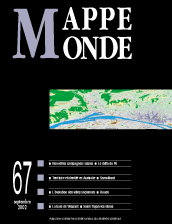

Neither passivity nor chaos: changes in land ownership and land use in Verkhni Ikorets (Russia) (5 fig.)
Verkhny Ikorets, a village in Russias fertile Central Chernozem Region, has gone through major changes in the last decade, as a result of the sweeping land privatisation reform initiated in 1991. This paper maps these changes diachronically on the scale of a single village, with special emphasis on farming structures and crop types. It shows that privatization does not necessarily entail de-collectivization of land and challenges two widely held ideas: Russian rural passivity and chaos.
keywords: CHANGES IN CROPPING, DE-COLLECTIVISATION, DIACHRONIC MAPPING, LAND PRIVATISATION, RURAL RUSSIA
Sylvie Roosen. Conquering land and reconquering identity in the Gulf of Carpentaria region (Australia) (4 fig.)
Four chronological maps are used to capture the geographical and cultural changes in the Gulf of Carpentaria region, whose strong pastoral identity is a pillar of the famous bush culture in the State of Queensland, Australia. This pioneering area, once a land of promise and prosperity, is now on the verge of marginalisation. On the one hand, Australians identify less and less with the bush and, on the other, the formerly segregated pastoral bush is now at the centre of Aboriginal claims on land.
keywords: ABORIGINAL LAND CLAIMS, AUSTRALIA, BUSH, FRONTIER, PERIPHERAL REGION, STATE OF QUEENSLAND
Équipe MTG-Rouen. Uncertain Rouen (7 fig.)
Rouen suffers from the proximity of Paris and the loss of its former strategic position in north-western Europe. Despite its natural endowments, the town is characterised by a dominant chemicals industry and the slow development of key services. The administrative division and social segregation of the urban area can be considered handicaps.
keywords: ENVIRONMENT, PARIS BASIN, SOCIO-SPATIAL SEGREGATION, URBAN AREA
The Po delta: a doubly unstable zone (2 fig.)
The morphological characteristics of the Po delta make the largest wetland in Italy a particularly instable space, that is very fragile when confronted with human pressure. The land improvements effectuated in order to develop the delta zone came to an end in the late 1960s, leading to an impressive system of intensive agriculture ; but it also has bad consequences on the natural and social environment. The recent creation of a natural park in order to try and protect the delta is faced with numerous obstacles, thus increasing the fragility of this natural zone and substantially changing traditional social structures in the Po delta, hence a doubly instable zone.
keywords: DELTA, ENVIRONMENT, LAND IMPROVEMENT, PO, WETLAND
Wissant Bay: 100 years of change in pictures (7 fig.)
A study of old postcards can effectively complement and refine an analysis of aerial photographs in map form. This method highlighted details of shore erosion and accretion in Wissant Bay.
keywords: WISSANT BAY (PAS-DE-CALAIS), OLD POSTCARDS, PHOTO INTERPRETATION, SHORELINE CHANGES
Sylvine Pickel. Representations of nature in the development of tourism in Saint-Trojan-les-Bains (4 fig.)
Nature representations have played a prominent part into the tourism development of Saint-Trojan-les-Bains, a small bathing resort of the Oléron Island. Since the coming of the first tourists on its coasts, at the end of the XIXth century, its natural spaces have been highligting like attractions. Theyre constant attractions, that still exist today, but also evoltive attractions, since their definition has never stopped changing, through decades.
keywords: AESTHETIC, BATHING RESORT, ENVIRONMENT, EVOTIVE ATTRACTION, HEALTH QUALITIES, HEDONISM, NATURE REPRESENTATIONS
From topography to history: understanding the development of ancient towns (6 fig.)
Archaeologists and historians are beginning to use geographers tools to analyse towns over the very long term. This paper describes an attempt to apply chorematic analysis to the history of four towns in the département of Yvelines, west of Paris. Their development over several centuries, even millennia, can be represented by a small number of explicative choremes.
keywords: ARCHAEOLOGY, CHOREMATIC ANALYSIS, HISTORY, MODELLING, TOWN, YVELINES
Somaliland, a young state seeking recognition (1 fig.)
Somaliland, a former British colony, composed of the Issak clan and three million people strong, unilaterally seceded from Somalia in 1991. The restored sea link between Berbera, the only harbour, and Addis Abeba, and the separation between Ethiopia and Eritrea have boosted Somalilands trade and enable it to compete modestly with Djibouti.
keywords: NGO AID, NOMADS, NON-RECOGNISED STATE, RER
Book reviews (Gilles Fumey, Céline Rozenblat)
Mappemonde 2/02![]()
![]() Mappemonde 4/02
Mappemonde 4/02
For subscribe or buy this issue: BELIN
Last modified: September 22, 2002